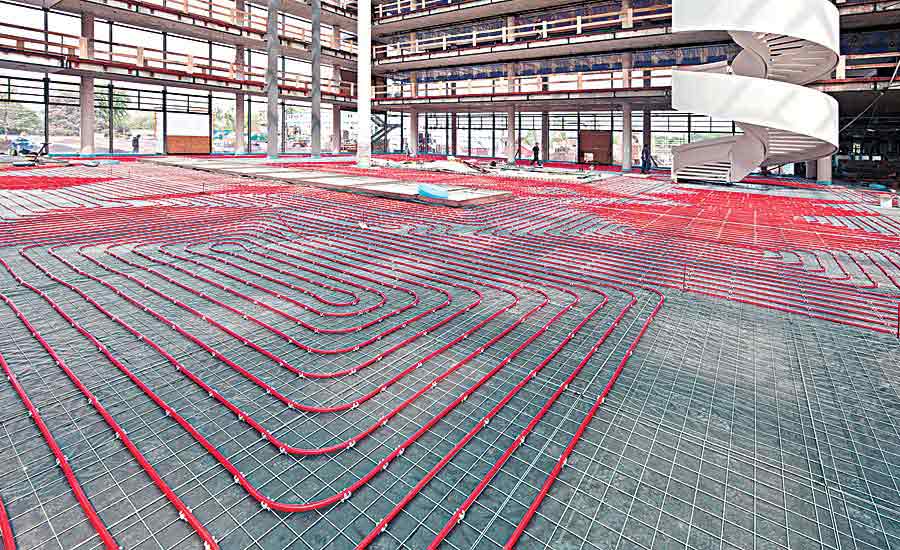Everything you need to know about the radiant cooling system
According to statistics, 40-50% of the building’s operational energy is consumed by HVAC systems. Over time, people have been trying to reduce the cost and improve the efficiency of these systems.
Traditionally, ACs have been widely adopted, however they produce uneven cooling. They can also lead to poor air quality by releasing airborne contamination. To overcome the problems caused by traditional cooling systems, architects and engineers look forward to the radiant cooling system as a solution. A well-designed radiant system is proven to offer effective cooling in most climates. Since it can significantly improve the air quality, they can be used in hospitals where good air quality is of utmost priority.
The radiant cooling system being laid out on the floor
What is a radiant cooling system?
The radiant cooling system uses polymer pipes or coils installed within the walls, floors, and ceiling. The coils are circulated with chilled water to cool down the surfaces by evenly absorbing heat from them. The system is generally integrated with a heating system and installed in sealed spaces for the best results.
- Cooling is evenly distributed and hotspots are eliminated
- The temperature of each room can be adjusted individually
- Coils can be installed under walls, ceiling, and floor as per the requirements
Working of radiant cooling system
Working principle:
The traditional cooling system cools by the process of convection whereas the radiant system transfers energy via radiation. Radiant cooling works on the principle that bodies with temperature differences exchange thermal radiations until equilibrium is achieved. Radiant cooling systems are combined with a large thermal mass which radiates as well as absorbs simultaneously.
Benefits:
- Energy-saving due to lower transport energy usage, efficient operating modes, and lower transmission losses
- Maintains thermal comfort by adjusting the indoor air temperature and relative humidity
- Components like ductwork, diffusers, grilles, air handlers, etc. are smaller in size
- Do not cause noise due to air movement
- Reduces operational and maintenance costs
- Efficient control over ventilation by allowing the required amount of outside air
It can easily be molded in the required shape
Demerits:
- In case of leakage or blocked coils, the supply of chilled water will be disrupted
- Efficiency is reduced in rooms that are not tightly sealed
- Condensate formation on surfaces results in mold formation
- Difficult to maintain a temperature below 23 degree Celsius
- Requires skills maintenance staff for controlling
The radiant cooling system can be integrated with a ventilation system to control humidity levels
Types of Radiant Cooling systems:
- Chilled floor/ceiling/wall: They induce air movement by the method of radiant and convective heat transfer. It lacks control over the humidity of the room and therefore should be integrated with a ventilation system.
Radiant cooling system installation detail
- Active chilled beam: The system uses a ventilation air duct passing through the chilled beam to cool the space. The ventilation air needs to be dehumidified upstream to prevent condensation at the chilled beam.
- Passive chilled beam: A radiator system is formed by surrounding a coiled pipe around the passive beam. The system is often combined with an under-floor air distribution system. The system should be paired with a ventilation system to maintain the moisture content in the room.
Chilled beam cooling system
The radiant cooling system is getting more and more popular with time. Though it has some limitations, yet they can be easily overcome by pairing it with other technologies. Advancement in design, high-efficiency, and sustainability are some of the factors which make a radiant cooling system better than its alternatives.

